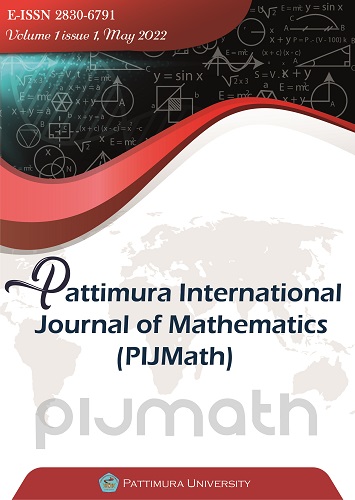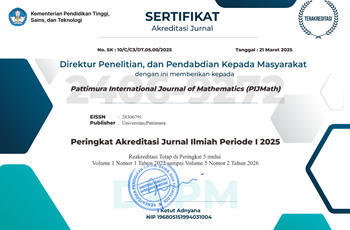Modeling Biodegradation of Polyethylene Terephthalate Involving the Growth of Factor Escherichia Coli Bacteria
Abstract
A design of a Polyethylene Terephthalate (PET) waste biodegradation system using Escherichia Coli (E-Coli) bacteria in a whole-cell biocatalyst system. E-Coli bacteria will produce LC-Cutinase enzyme on the cell surface so PET can be broken down into Ethylene glycol and Terephthalate acid. With the help of Reductase and Dehydrogenase enzymes, a chemical reaction occurs that converts Ethylene glycol into Malate. Through the chemical reaction process, it is guaranteed that Ethylene glycol does not explain the environment but can be used as an energy source for the growth of E-Coli bacteria. Thus E-Coli can grow faster, so the more bacteria, the more PET that can be broken down quickly.
Downloads
References
United Nations Environment Programme, “Drowning in Plastics – Marine Litter and Plastic Waste Vital Graphics”, 2018, [Online]. https://www.unep.org/interactives/beat-plastic-pollution/ [access on date: April 2, 2022].
Gaelle, Gourmelon, “Global Plastic Production Rises, Recycling Lags”, 2015, [Online]. http://www.worldwatch.org/ [access on date: April 2, 2022].
Kemenkopukm, “MenKopUKM Berharap Pendirian Pabrik Air Minum Ma'soem Group Dorong Perekonomian Majalengka”, 2022, [Online]. https://kemenkopukm.go.id/read/menkopukm-berharap-pendirian-pabrik-air-minum-ma-soem-group-dorong-perekonomian-majalengka [access on date: May 15, 2022].
IGEM, UC Davis, “Ethylene Glycol Modules”, 2012, [Online]. http://2012. igem.org/Team:UC_Davis/Project/Catalyst [access on date: April 5, 2022].
IGEM, ITB, “ColiPlaster”, 2014, [Online]. 2014.igem.org/Team:ITB_Indonesia [access on date: April 20, 2022].
E.Klipp, R.Herwig,A.Kowald,C.Wierling,H.Lehrach, System Biology in Practice Part II: Standar Model and Approaches in System biology, Michaelis-Menten kinetics. WILEY-VCH, 2013, 144-148
E. Herrero Acero, D. Ribitsch, G. Steinkellner, K. Gruber, K. Greimel, I. Eiteljoerg, E. Trotscha, R. Wei, W. Zimmermann, M. Zinn, A. Cavaco-Paulo, G. Freddi, H. Schwab, and G. Guebitz, “Enzymatic Surface Hydrolysis of PET: Effect of Structural Diversity on Kinetic Properties of Cutinases from Thermobifida,” Macromolecules, vol. 44, no. 12, pp. 4632–4640, May 2011 Available at: http://dx.doi.org/10.1021/ma200949p
S. Sridhara, T. T. Wu, T. M. Chused, and E. C. C. Lin, “Ferrous-activated Nicotinamide Adenine Dinucleotide-linked Dehydrogenase from a Mutant of Escherichia coli Capable of Growth on 1,2-Propanediol,” Journal of Bacteriology, vol. 98, no. 1, pp. 87–95, Apr. 1969. doi:10.1128/jb.98.1.87-95.1969
N. Obradors, E. Cabiscol, J. Aguilar, and J. Ros, “Site-directed mutagenesis studies of the metal-binding center of the iron-dependent propanediol oxidoreductase from Escherichia coli,” European Journal of Biochemistry, vol. 258, no. 1, pp. 207–213, Nov. 1998. doi:10.1046/j.1432-1327.1998.2580207.x
L. Baldomà and J. Aguilar, “Involvement of lactaldehyde dehydrogenase in several metabolic pathways of Escherichia coli K12.,” Journal of Biological Chemistry, vol. 262, no. 29, pp. 13991–13996, Oct. 1987.
J. M. Lord, “Glycolate oxidoreductase in Escherichia coli,” Biochimica et Biophysica Acta (BBA) - Bioenergetics, vol. 267, no. 2, pp. 227–237, May 1972. doi:10.1016/0005-2728(72)90111-9
D. M. Anstrom, K. Kallio, and S. J. Remington, “Structure of theEscherichia colimalate synthase G:pyruvate:acetyl-coenzyme A abortive ternary complex at 1.95 Å resolution,” Protein Science, vol. 12, no. 9, pp. 1822–1832, Sep. 2003. doi:10.1110/ps.03174303
T. Talib, “Model Regulasi Pada Proses Biodegradasi Polyethylene Terephthalate (PET)”, BAREKENG: J. Il. Mat. & Ter., vol. 10, no. 2, pp. 107-105, Dec. 2016.
T. Talib, “Degradation Model of Polyethylene Terephthalate By Escherchia Coli Bacteria”, BAREKENG: J. Il. Mat. & Ter., vol. 12, no. 2, pp. 053-060, Dec. 2018.
The author(s) hold the copyright of the published article without restriction. This policy means that the journal allows the author(s) to hold and retain publishing rights without restrictions.
The author(s) holds the copyright of published articles without limitation. This policy means that the journal allows the author to hold and retain publishing rights without restrictions. Journal editors are given the copyright to publish articles in according to agreement signed by the author and also include statement of originality of the article


.jpg)












 This work is licensed under a
This work is licensed under a 